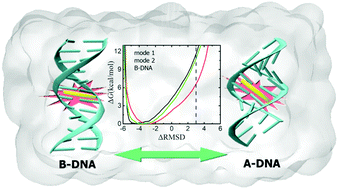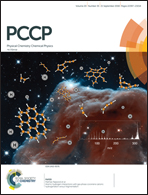Conformational changes of DNA induced by a trans-azobenzene derivative via non-covalent interactions†
Abstract
In biological environments and in aqueous solution, DNA generally adopts the canonical B conformation. Recently, an azobenzene photoswitch containing a polyamine chain with three positive charges was shown to induce a reversible conformational transition between the A and B forms of DNA, the transition being triggered by trans–cis isomerization of the photoswitch upon non-covalent intercalation. It was proposed that, in its trans conformation, azobenzene stabilizes the A form of DNA. The structural details and the mechanism upon which trans-azobenzene induces the B-to-A DNA transition remain, however, unclear. In the present work, two possible intercalating modes of trans-azobenzene, from the minor groove and from the major groove, were investigated with all-atom molecular-dynamics simulations. Intercalation from the major groove was found to be the most probable binding mode due to favorable electrostatic and π–π stacking interactions. The free-energy profile associated with the B-to-A conformational transition reveals that intercalation from the major groove leads to a conformational change of DNA, showing a slight tendency to interconvert from B- to A-DNA, in agreement with the CD spectrum obtained from the experiment. However, the presence of only one interacting azobenzene is not sufficient to lead to a global conformational change to A-DNA. The present results are expected to serve in the design of DNA switches, which can induce reversible DNA conformational changes.



 Please wait while we load your content...
Please wait while we load your content...